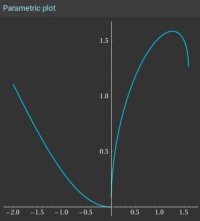No, you can't.
Can you tell us why not?
The particular issue I hoped you would see is this, which I called your attention to:
y(3t−y2)=t3
can i say
y=t3 and
3t−y2=t3
If you know that AB = C, does it follow that A = C and B = C? No, that's true only if C = 0. (And even then it would be "or", not "and".)
in my previeous post, BigBeachBanana and Dr.Peterson say i have the freedome to choose any parametrization. also Dr.Peterson say we choose and try, if it doesn't work, we choose something else. this look messy but it is my first try
If you were to follow through on your correct statement that
y=3tt3+y3, the next step would be to solve for y as a function of t. That isn't easy. (In fact, y is not a function of x!)
So, yes, it is messy. It would have been my first try, too!
Now you have to try something else. I have my own idea, which I got after using Desmos to graph the equation, in order to more quickly see what sort of parameter might work -- that is, as you go along the curve, what about it might change in a consistent way? (Using x = t would force you to move from left to right, and the curve doesn't do that.) But I might have thought of it without first doing that first; in fact, before modern software made it easy to visualize complicated equations, I wouldn't even have had that option.
I don't know of a general method for finding a parametrization, or software that would do it, but I am not up on all the latest methods.
But the idea I considered, which turned out to work, is to first try putting the equation in
polar form, in the hope that that might reveal another variable I could use for t. (
@Otis's graph is a function of x, and doesn't completely represent the equation.)
Another thing I wanted to ask: What is the
context of your question? If it's a problem you were given, please quote it completely, so we can see if there were any implied hints we could point out. Again, parametrization is not an inherently easy thing to do; you have to recognize possibilities, which come with experience as I've said, and often context (that is, why you want to parametrize) provides ideas.

